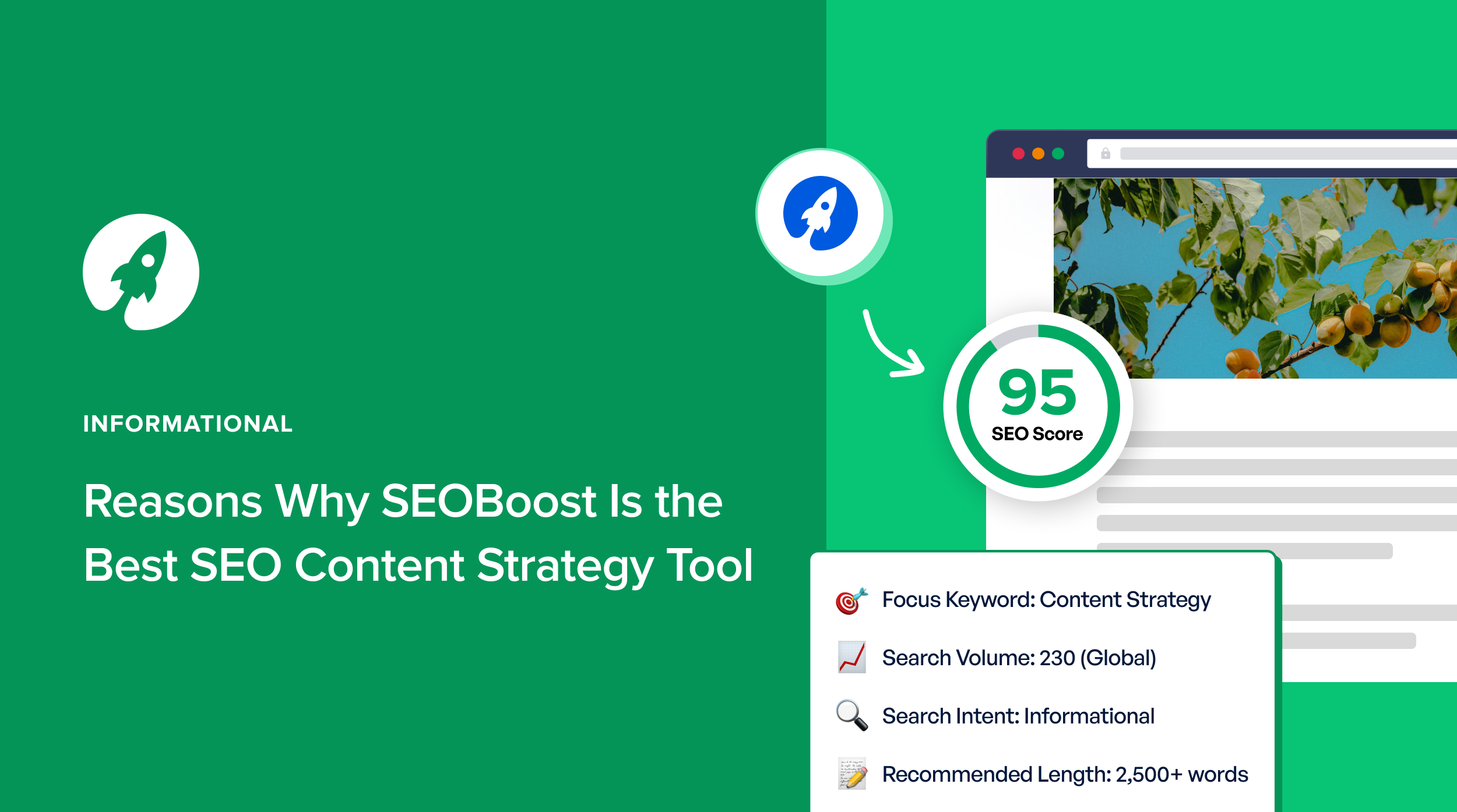If you want to turn your content ideas into serious organic traffic, you need the right content strategy tool.
With content becoming more competitive than ever, having a content strategy tool that helps you find the right keywords, create optimized briefs, and track performance is essential.
That’s where SEOBoost comes in.
Designed for content creators, marketers, and SEO strategists, SEOBoost combines every stage of the content creation process into a single workflow. This makes it one of the best SEO content strategy tools for business owners.
In this blog, I’ll break down what makes a content strategy tool effective and why SEOBoost checks every box.
Let’s start with a definition.
- What Is a Content Strategy Tool?
- What Makes SEOBoost the Best SEO Content Strategy Tool?
- 1. Topic Reports: Find High-Potential Keywords and Trending Topics
- 2. Content Briefs: Streamline Content Creation With Detailed SEO Guidelines
- 3. Content Optimization: Real-Time Recommendations for SEO-Friendly Content
- 4. Content Audit: Evaluate and Improve Existing Content
- 5. Content Management: Track and Manage All Your SEO Content Efforts
- SEO Content Strategy Tools FAQs
- Final Word
What Is a Content Strategy Tool?
A content strategy tool is an SEO software designed to help you plan, create, optimize, and manage content that aligns with your SEO and marketing goals.
It acts as a central hub for organizing content ideas. You can also use it to track SEO performance, which helps ensure that your marketing efforts are both strategic and measurable.
These tools are essential for businesses and content creators aiming to grow through organic search. Instead of guessing what to write, a content strategy tool provides you with data-backed insights to go for the right keyword strategy.
Once you have locked in on the strategy, you can create SEO-optimized content and ensure consistency across your content marketing efforts.
SEOBoost takes this a step further by offering a complete toolkit for research, briefs, optimization, audits, and content management, making it an all-in-one strategy engine for SEO content.
Why a Strong SEO Content Strategy Is Key to Success
Without a solid SEO content strategy, even the best-written blog posts can fall flat in search results.
Strategy is what turns isolated content pieces into a cohesive, high-performing ecosystem.
So, when you plan your content around SEO goals, you build long-term momentum.
Now, your goals can vary based on your business standing and requirements. It can be something as small as increasing organic traffic or as niche as targeting specific buyer intent, or ranking for competitive keywords. In any case, the right SEO tool helps you get there.
A strong SEO strategy ensures:
- Consistency: You’re publishing regularly and addressing relevant topics that match user search intent.
- Optimization: Each piece of content is optimized from the start, not as an afterthought.
- Scalability: As your website grows, you’re adding content with value.
- Measurability: You can clearly track what’s working and what needs improvement.
From experience, I’ve seen clients dramatically boost their organic rankings not simply by writing more, but by writing more strategically.
What Makes SEOBoost the Best SEO Content Strategy Tool?
Now, let’s get to my favorite part: how does SEOBoost fit into all this?
Let’s look into each of its 5 winning features and see what problems it solves in the content pipeline.
1. Topic Reports: Find High-Potential Keywords and Trending Topics
One of the hardest parts of content strategy is figuring out what to write about. Without strong topics that match search demand, your blog post won’t rank, no matter how well it’s written.
That’s where Topic Reports come in.
Before I used SEOBoost, I’d spend hours manually researching keywords and analyzing competitor content.
Now, I get a complete view of the most promising content opportunities in minutes.
SEOBoost’s Topic Reports generate 7 different types of reports for your focus keyword.
This helps you understand the depth of the keyword in detail and assess the associated phrases and questions to use.
You also get a peek into the top-ranking SERPs, which helps you fill the content gap easily.
Honestly, what I like the most about this feature is that it literally takes a few seconds to generate all this data.
And it automatically syncs with the other features, such as the content optimization editor, making it super efficient.
Now, I know that most keyword research tools offer keyword data like volume, difficulty, and intent. And I do use these tools to get this data since they’re not included in SEOBoost. However, I’ve also noticed that they pair really well with SEOBoost because once I’ve locked in on the keyword, I can dive deeper into its analysis.
You can pair SEOBoost’s Topic Reports with other keyword research tools like LowFruits and Semrush for a more comprehensive keyword strategy.
So, what makes SEOBoost stand out?
I love that SEOBoost shows data that most tools don’t. This includes the outbound URLs the top-ranking pages have linked to, image alt text to use, and even questions to target the People Also Ask section.
It’s going after that last 2% of content optimization part that makes it a winner for me (and my content).
2. Content Briefs: Streamline Content Creation With Detailed SEO Guidelines
Even the best writers need direction, and that’s what content briefs provide.
Content briefs are your roadmap. They align writers, editors, and SEO teams on what needs to be written, why, and how to structure it for maximum SEO impact. For me, a solid brief means fewer revisions, faster turnaround, and more consistent rankings across the board.
I’ve worked with SEO tools that give you a basic keyword and call it a day. SEOBoost, on the other hand, delivers genuinely helpful briefs.
Each brief generated by SEOBoost includes:
- Primary and secondary keywords, with usage guidelines
- Suggested H1-H3 subheadings based on SERP trends and content gaps
- Word count targets based on competing content
- Top questions from People Also Ask and forums to address audience curiosity
What I love most is that you can add notes for each heading. These notes can be for yourself or, if you’re giving the brief to another writer, they can refer to them for more context.
This way, you eliminate the chances of any miscommunication.
I’ve used these AI content briefs myself. Not only do they cut briefing time in half, but they also ensure every post is structured to rank. That’s crucial if you want to scale your content marketing without sacrificing quality or SEO performance.
3. Content Optimization: Real-Time Recommendations for SEO-Friendly Content
Writing content that ranks isn’t just about picking the right keyword.
That’s only half the work.
Once you have that, you should also look into how to structure your post, how well it reads, and whether it checks all the on-page SEO boxes. That’s where real-time optimization becomes a game-changer.
You can have a great blog topic and solid writing, but if your content lacks structure or skips important SEO elements, like keyword density or internal links, it probably won’t rank.
I’ve seen high-quality content underperform simply because they weren’t properly optimized.
What sets SEOBoost apart is that it gives you live SEO feedback while you’re writing. You don’t have to finish a post, copy and paste it into another tool, and then start optimizing. Everything happens in one place, in real time.
And the editor itself is really simple to navigate.
You get the readability and content checks, as well as guidelines for important phrases and words to include. This makes content optimization super easy and efficient.
Each change you make instantly updates your content’s on-page SEO score.
From an E-E-A-T perspective, this real-time feedback loop helps me write more trustworthy, accurate, and SEO-optimized content faster.
4. Content Audit: Evaluate and Improve Existing Content
Even the best content gets stale.
Over time, algorithms change, competitors outrank you, and what once performed well may start to slip. That’s why auditing your existing content is just as important as creating new posts.
I’ve worked with countless teams that publish consistently, but forget to look back. Without a content audit process, you’ll overlook content decay, missing internal links, or under-optimized content.
Worse, you might not realize some posts are actively hurting your rankings due to poor performance or duplicate content.
Content audits are essential for maintaining topical authority, improving traffic, and showing Google your site is active and relevant.
With SEOBoost, you can analyze the performance of the existing content.
SEOBoost scans your entire content and assigns it a content score.
Then, it tells you why a post may be underperforming and what to do about it.
You’ll get a color-coded report that highlights specific recommendations to improve your content quality.
With traditional content marketing tools, content audits can take hours, manually checking scores, cross-referencing with analytics, and mapping out next steps.
SEOBoost simplifies all of that. Its audit insights are based on real-time SERP data, helping me make decisions backed by evidence.
5. Content Management: Track and Manage All Your SEO Content Efforts
A successful content strategy framework is about how you manage it all behind the scenes.
From assigning tasks to tracking content performance, having a centralized system is critical if you want to scale without chaos.
I’ve worked with both small teams and enterprise-level content operations.
No matter the size, the same problem comes up: once your content calendar grows beyond a few posts, things start slipping through the cracks. Writers miss deadlines. Optimization tasks pile up. Nobody knows which draft is the latest version.
Without the right content management tools, even the best strategies fall apart.
SEOBoost solves this with a content management dashboard built specifically for SEO content. Over the years, I’ve learned that this is something that most project management tools just can’t do.
Each blog post lives in its workspace, where you can attach briefs, check SEO scores, assign due dates, and set deadlines.
You can also assign roles, track revisions, and share updates with writers or editors, without needing 10 different Slack messages.
But my favorite part of this feature is the media library, where you can upload and store all your visual content.
You can also access stock photos from here, if need be. Or just use it to categorize your brand assets.
If you’re looking for a content strategy tool that allows you to store your visual data as well, this would be it.
SEO Content Strategy Tools FAQs
What are SEO content strategy tools?
SEO content strategy tools are software solutions that help you plan, create, optimize, and manage digital content. In SEO, content tools like SEOBoost provide keyword insights, optimization suggestions, content briefs, and performance tracking to help improve visibility and rankings.
What are the 4 steps of content strategy?
The 4 essential steps in a content strategy include research and planning, content creation, optimization and publishing, and tracking and improvement. These steps ensure that your strategy is optimized for success from the beginning.
What are the 4 C’s of content creation?
The 4 C’s of content creation are clarity, consistency, credibility, and creativity. Together, they help you create a winning and long-term SEO content strategy.
Final Word
As someone who’s worked in content strategy for years, I’ve seen firsthand how much time and money are wasted jumping between tools that don’t integrate.
SEOBoost solves that problem, giving me a single platform to build, optimize, and scale my content strategy with confidence.
If you’re looking to streamline your SEO workflow, SEOBoost is the best SEO content strategy tool for creating content that ranks and converts.




